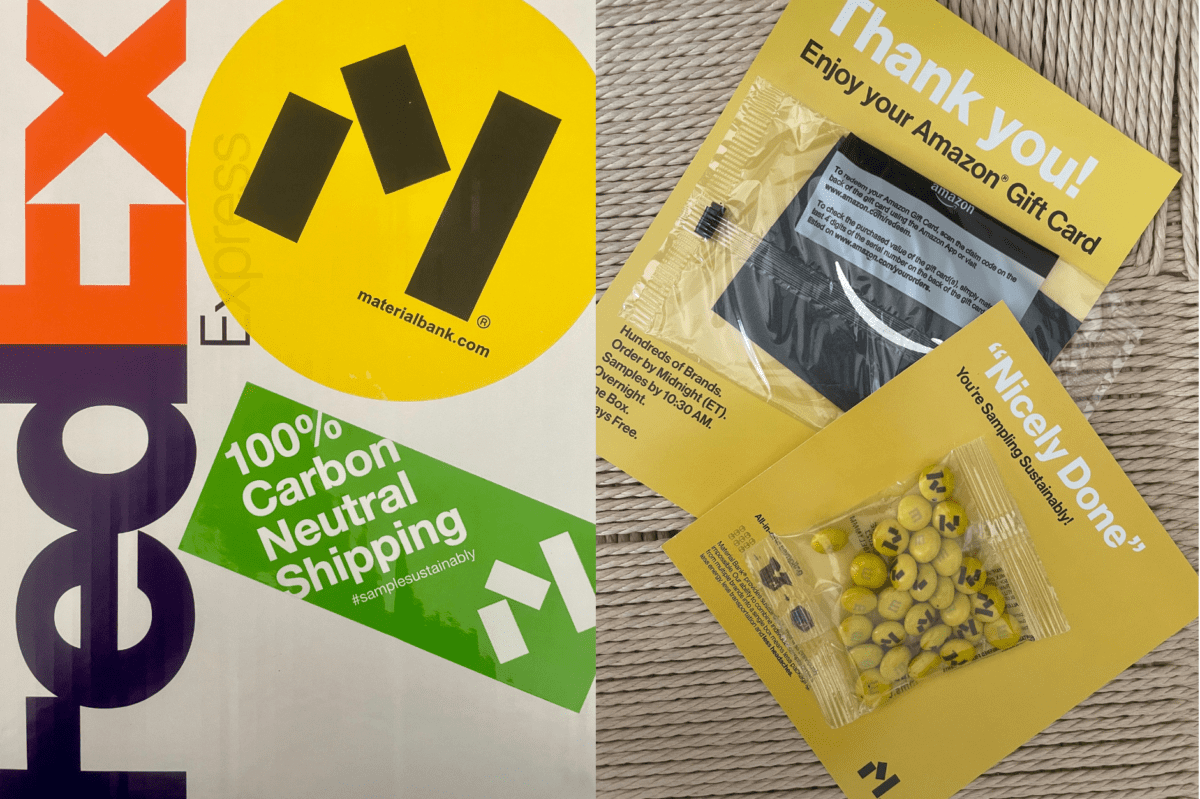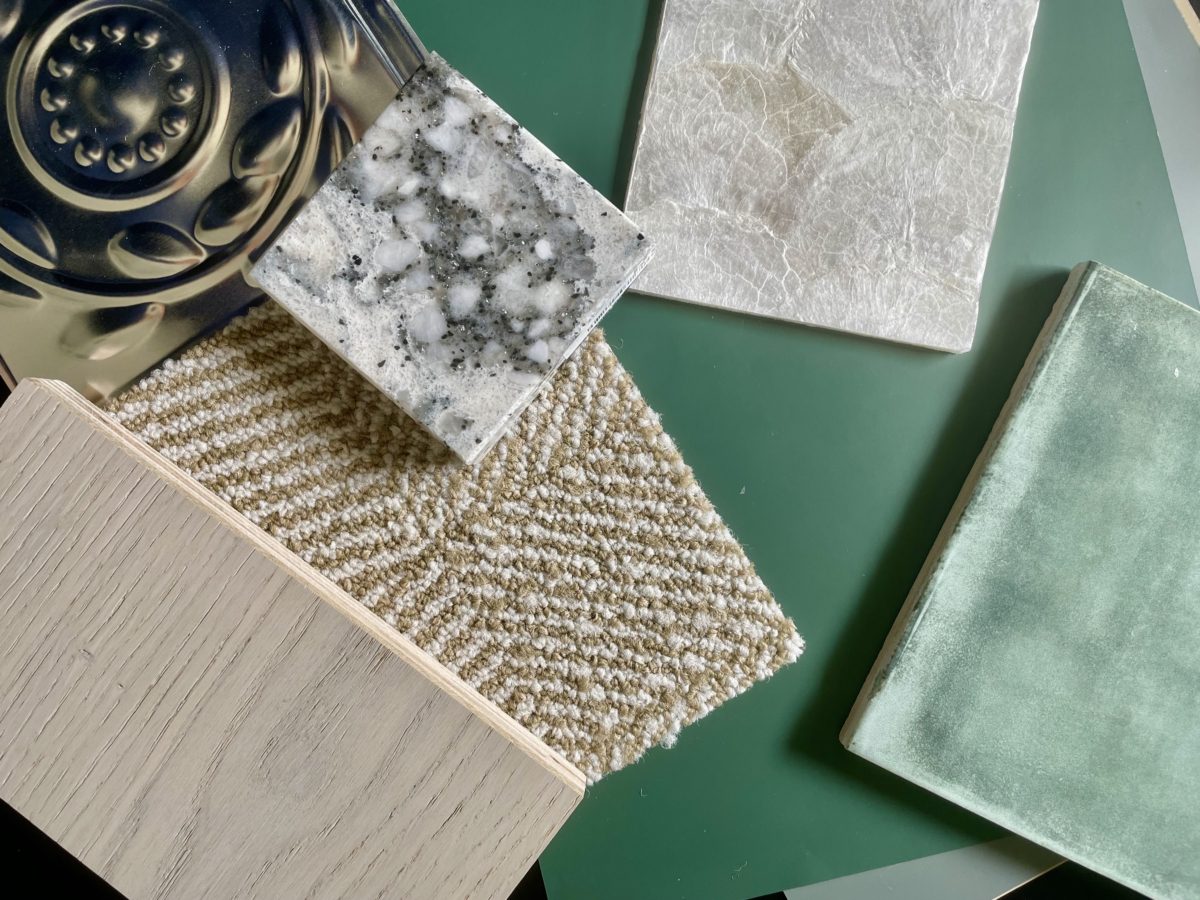Have you considered rethinking your sampling process?
By sampling sustainably, you could make a huge impact on the planet.
Material Bank is at the forefront of this mission. This material marketplace aggregates samples from numerous brands into a single box, offers carbon-neutral shipping, and more!
Ahead, we’re taking a deeper dive into sustainability in design. And recapping Material Bank’s Education Series: Design Your Impact for a Healthier Future—the best jumping-off point for becoming a more environmentally conscious design professional.
Who is Material Bank?
Material Bank is the world’s largest material marketplace for architecture and design professionals. This platform offers a powerful and fast way to search and sample hundreds of options from paint, tile, rugs, to wood, and wallpaper.
The best part: you can discover new products and brands on one site. Plus, it’s completely free to design professionals since Material Bank is not a “freemium” service (and will never ask you for any credit card information).
And if you order samples by midnight (ET), your delivery swings in by 10:30 AM the next day in one organized black box. If you need recommendations, assistance finding a material, or just have questions, Material Bank also offers a “Ask A Material Expert” feature. However, what truly sets Material Bank apart is their primary mission: to empower architecture and design industries to support climate action.

What Makes Material Bank Eco-Friendly?
Material Bank aims to improve the sustainability of architecture and design industries significantly.
By sampling across multiple brands (and placing every sample into a single box), Material Bank accomplishes this goal by eliminating unnecessary shipments and reducing waste.
To date, they have already reduced the number of inbound packages to firms by over 80%.
Material Bank can provide this service because they’ve built a large-scale, super-efficient distribution center in Memphis, Tennessee—which houses millions of samples from leading brands under one roof. This is how Material Bank can combine multiple sample requests from various brands into one box. In this way, they’ve stopped the need for unnecessary warehouses, trucks, packages, and airplanes.
Plus, they have a sample return program, which allows Material Bank to reclaim and reuse their architecture and design samples (versus pieces ending up in landfills).
They even use recycled paper for any cards or printouts they include in their boxes.
What does Sustainability Mean for Design & Architecture Professionals?
Why is Material Bank focused on eco-friendly design and why does sustainable design even matter?
Sustainable design seeks to reduce negative impacts on the environment while increasing the health and comfort of people.
For example, consuming renewable resources is a simple way to become more sustainable. Or, finding ways to minimize waste wherever possible in your design process.
Did you know? 9 million tons of furniture end up in landfills per year (according to the U.S. Environmental Protection Agency). This equals 18,000,000,000 pounds of furniture dumped annually!

What did Material Bank’s Education Series: Design Your Impact for a Healthier Future Cover?
Material bank hosted a virtual education series to discuss design’s social, human, and climate health. Each session was led by a leader from one of Material Bank’s Carbon Impact Program firms who discussed a unique topic. The ultimate goal of this series was to inspire design professionals to tweak their processes in favor of healthier, eco-friendly practices.
Some of their firm partners Join firm partners AECOM, CannonDesign, HMFH, HOK, M+A Architects, Perkins & Will, and Studio O+A.
All of their sessions were live-streamed and recorded so that you can tune into every topic here!
What is Material Bank’s Carbon Impact Program All About?
Material Bank partners with firms on their sustainable design journey. Their goal is to provide insight into each design firm’s sampling impact and give them digital tools to improve their sustainability processes.
For example, they offer customized firm-wide training in sustainability (with digital project support). They also give firms quarterly sustainability impact reports, where you can track your metrics for packages saved and shipping carbon credits.
As of October 2020, Material Bank has purchased carbon credits funding for verified carbon reduction and removal projects worldwide, equivalent to 1500 metric tons of CO2. Material Bank also covers all shipping fees for carbon-neutral shipments.
To get the full scoop on their carbon impact program, you can learn more here!
How Can You Make a Difference?
Sometimes it’s not about pricey, grand changes but making minor tweaks in your process that can make all the difference. Here are a few easy ways you can start practicing design more sustainably:
- Focus on the 3Rs: Reduce, Reuse, and Recycle. When using construction materials in your projects, brainstorm which parts can be reused to give them a second life. Need some inspiration? Check out a few exciting examples of material reuse by Re-Thinking The Future.
- Use materials and brands produced in a socially-responsible manner.
- Plan for energy-efficient lighting.
- Donate, consign, and redistribute products.
- Collaborate with additional design professionals in your area to share and/or donate products you no longer use.
- Consider joining and supporting organizations like the Good Future Design Alliance.
Streamline your design projects and check more tasks off your to-do list!
At Gather, our interior design project management software is for design teams just like yours. Our all-in-one platform will simplify your everyday designing, from specifying materials and communicating centrally to tracking purchasing status. Take a look at all our features here and start a FREE trial to see how Gather will help you (and your team)!

Shivani is an expert writer for Gather who covers interior design, decorating, and home improvement. She has worked as a residential interior designer for 4+ years and has extensive training in space planning, 3D renderings, 2D floorplans, whole room furnishing and décor, and color consulting. She is passionate about educating communities on industry topics and has been featured in Better Homes & Gardens, The Spruce, My Domaine, Domino, Martha Stewart, and Atlanta Magazine. Currently, she is also completing her residential interior design certificate from Rhode Island School of Design’s continuing education program.



